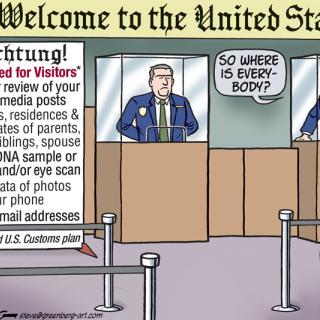Am I the only Ohioan who has mixed reactions to the blasting news of the highly secretive and delayed announcement of Intel’s aspirational plans to build the “world’s largest” computer chip manufacturing “fab” in New Albany/Licking County? Am I the only reader disturbed by the no-longer-daily, little-news Columbus Dispatch’s Saturday, Jan. 22, front page and much of the first section’s unchecked press release for Mike DeWine’s and Jon Husted’s re-election campaign? This continued in the Sunday, Jan. 23, edition. I hope I’m not.
I support all responsible job creation and economic development. Let there be no doubt about that.
At the same time, I am committed to transparency, public information and public input, and respect for democratic values, norms, and practices. The latter are disturbingly absent in the state’s (and so far unclear federal and local) luring and bargaining with Intel that begin in May 2021, according to the Dispatch’s transcript of their “hours-long” private press conference with the DeWines and Husted, that masquerades as three front-page “news” articles by one reporter: Mark Williams, “Intel in Ohio: How the deal was done.” This is neither news reporting nor responsible journalistic practice. Compare it with the matter-of-fact articles in the New York Times, Washington Post, and Wall Street Journalon the same day. Yes, I know better than to compare these differently imperfect media outlets. (See my column, “The Columbus Dispatch: The decline of a metropolitan daily newspaper.”)
In incomplete and, to my reading, self-serving and distracting comments, neither DeWine and Husted nor Intel’s CEO Patrick Gelsinger clarify or detail the process that, according to the Dispatch’s multi-page press release, converged from May to final terms on Christmas Day 2021 and public announcement nearly a month later on Jan. 20-21 (leaked by a county trustee a week earlier). The state’s, localities’, local corporations’, and local colleges’ and universities’ formal commitments and rhetorical promises are nowhere specified, despite most of it being dependent on public monies. Whatever degree of secrecy was expected while 40 to 50 sites competed for the “fab” disappeared by late fall.
“Silicon Valley Heartland,” “Silicon Valley Midwest,” and “Silicon Heartland”—yes—has been bought and sold, but the actual payers and residents remain in the dark, chipless as it were. Intel “Heartland” will not begin to confront the world-wide chip shortage before 2025. The tax-paying public is not told the details of the incentive package(s) that developed over those eight to nine months of take and give negotiations.
Intel does not announce a formal plan or timetable, whether of acreage and modes of acquisition (which will disturb Licking County and pit small localities against the annexing New Albany); size and number of factories—“fabs” and “megafabs,” in Gelsinger-speak; or number of permanent and temporary employees—and their educational requirements and salaries (the stated “average” salary of more than $130,000 does not square with known realities). Job guesstimates range wildly over thousands.
Gelsinger claims that “We are putting our chips on the table,” when he is empathically not. He goes a step farther at a Jan. 21 White House event promoting the not-yet-passed by the U.S. House of Representatives CHIPS Act, “but this project will be bigger and faster with the CHIPS act.” Ohio’s congressional representatives remain silent. The Senate passed the bill last Spring.
Gelsinger confuses Ohio with Texas when he states, “We want to grow this to be a megafab location that is one of, if not the biggest of, any semi-conductor locations on the planet.” Everything is bigger in Ohio now? “Grow this” must also be Gelsinger-speak. (Texas Gov. Abbott must be steaming, as long as his unrepaired power grid holds in advance of February’s weather forecasts.)
The touted benefits to New Albany, Licking County, the state, and the nation range from completely aspirational to wholly self-promotional and self-serving. The absence in 2021-2022 of any comment on the environmental impact or a formal environmental review of such a massive redevelopment of “farmland” is inexcusable.
No concern is expressed, nor any mention made, of the need to prepare for the disruption to all dimensions of the affected area. Suburban New Albany and Licking County are misrepresented not only as “farmland.” They are poorly described as home to “massive data centers,” and the unedited Dispatch articles contradict themselves on the price of houses and the affordability of living in New Albany/Licking County. Area communities are ill-prepared to deal with the multiple impacts of Intel’s fabs. The housing market will be upended.
The Dispatch paraphrases Husted’s familiar refrain that “Ohio has a history as a manufacturing powerhouse.” That is at best a partial truth—in other words, a myth. Northeast Ohio was once a “powerhouse.” Cincinnati has Procter and Gamble. Yes, Ohio past and present had been home to a scattering of plants. But to this historian, a history of dispersed automobile and other plants does not constitute “a powerhouse.” Intel’s aspirational 3,000 new jobs (up to an imaginary 10,000 including temporary construction workforce, at some undefined time, a “mini-city”) does not constitute a “powerhouse,” a new “Silicon Valley Heartland” (is that a contradiction in terms?), or a “mini-city.” There is no reality in this spasm of superficial sloganeering.
Husted tops off this outpouring about the announcement of a not-yet-detailed or ground-broken “fab” by telling his Columbus Dispatch press agent, that on Christmas Day when he received a letter from Gelsinger and Intel, he commented, “This is the greatest professional gift that I could ever achieve. I remember turning to my wife and saying, ‘Ohio won.’ This is an historical economic achievement.” “Professional gift … achieved”? “Historical economic achievement”? Can someone translate? (Is this a continuing symptom of his “Wuhan virus”?)
Even more ludicrous is one of our familiar candidates for Columbus booster in chief, Alex Fischer, former CEO of the Columbus Partnership, “who was involved in the Intel negotiations,” he told the Dispatch. Not recognizing that Jersey Township in Licking County is not part of Columbus, Fischer utters, “No one will ever call us a cow-town ever again, but the real opportunities are ahead of Columbus and Ohio. You live to play for the Super Bowl and we won today. It feels great.” Fischer confirms my arguments in “Columbus, Ohio, searches to be a city: The myth of the Columbus Way.” (See also Kevin Cox, Boomtown Columbus, Ohio State University Press, 2021.)
No one ever ever seriously called Columbus a cowtown or confused it with a ranching or even farming town, even when it once served a farming area. (The Dispatch’s Editorial Board recently unknowingly interchanged “cowtown” and “croptown” in a typically uninformed statement.) Former mayor Buck Reinhardt commented off-handedly that no one should ever again use that phrase, that was in fact almost never (not ever) used. Of course, I may misinterpret Fischer’s verbiage, between “ever ever,” “ahead of,” and “Super Bowl.” My Google translator doesn’t cover this rhetoric that is symptomatic of the language of the fictitious “Columbus Way.”
The Ohio Way and the Columbus Way are one but not “won” or done.
Note: an update to my “The Columbus Dispatch: The decline of a metropolitan daily newspaper,” Busting Myths, Columbus Free Press, Jan. 20, 2022. In her (Guest Essay or Editorial?) statement on page 1F on Jan. 23, 2022, interim editor Kelly Lecker continues Alan Miller’s unjournalistic cheerleading for her publication. This time she confuses the historical tradition of “shoe-leather reporting” with the new, “empathetic,” non-reporting practice of dispatching one or two regular reporters to sit in the misidentified, stationary “mobile newsroom” that parks near a branch of the Columbus Metropolitan Library and waits for locals to stop by. Neither Miller nor Lecker mentions that these reporters are removed, and not replaced, on their regular beats for two weeks. Will the “mobile newsroom” next visit the few cows in the annexed “Cowtown” areas of “Silicon Valley Heartland”? These funds would be much better invested in a copy editor and literate headline writers, as well as page layout—which both reporters and readers desperately desire but with which Miller and Lecker are apparently unfamiliar.
Harvey J. Graff is Professor Emeritus of English and History and Ohio Eminent Scholar at The Ohio State University. He is the author of many books on social history. His new Searching for Literacy: The Social and Intellectual Origins of Literacy Studies will be published by Palgrave Macmillan in 2022. His essays appear in Inside Higher Education, Times Higher Education, Washington Monthly, Academe, Publishers Weekly, and other outlets. His specialties include the history and present condition of literacy and education including higher education, children and families, cities, interdisciplinarity, and contemporary politics, culture, and society. He thanks Kevin Cox for his comments.



